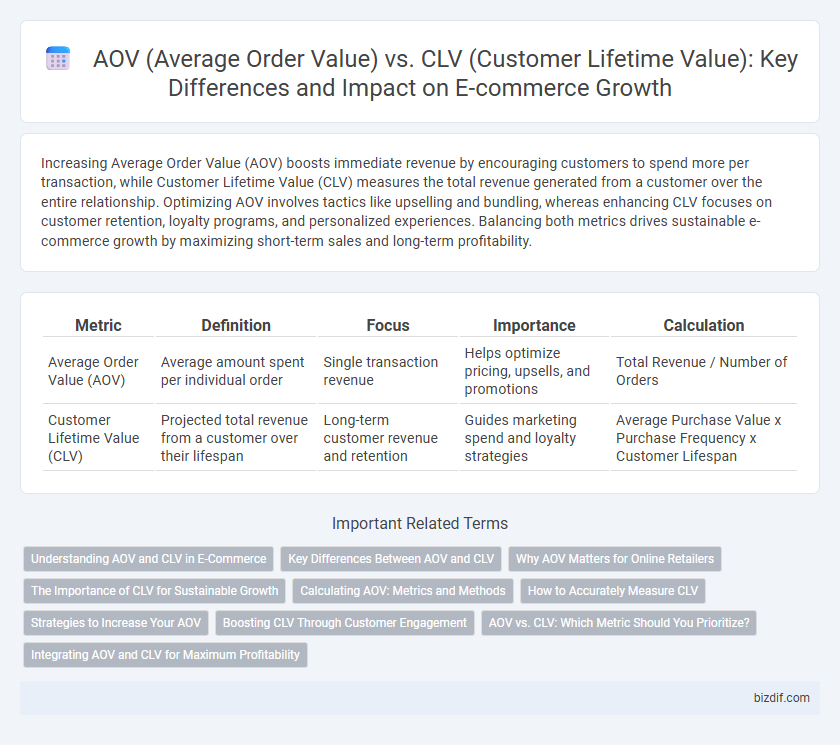Increasing Average Order Value (AOV) boosts immediate revenue by encouraging customers to spend more per transaction, while Customer Lifetime Value (CLV) measures the total revenue generated from a customer over the entire relationship. Optimizing AOV involves tactics like upselling and bundling, whereas enhancing CLV focuses on customer retention, loyalty programs, and personalized experiences. Balancing both metrics drives sustainable e-commerce growth by maximizing short-term sales and long-term profitability.
Table of Comparison
| Metric | Definition | Focus | Importance | Calculation |
|---|---|---|---|---|
| Average Order Value (AOV) | Average amount spent per individual order | Single transaction revenue | Helps optimize pricing, upsells, and promotions | Total Revenue / Number of Orders |
| Customer Lifetime Value (CLV) | Projected total revenue from a customer over their lifespan | Long-term customer revenue and retention | Guides marketing spend and loyalty strategies | Average Purchase Value x Purchase Frequency x Customer Lifespan |
Understanding AOV and CLV in E-Commerce
Average Order Value (AOV) measures the average amount spent by a customer per transaction, highlighting immediate revenue potential for e-commerce businesses. Customer Lifetime Value (CLV) calculates the total revenue a customer generates over their entire relationship with the brand, reflecting long-term profitability. Analyzing both AOV and CLV helps optimize marketing strategies, improve customer retention, and increase overall business growth.
Key Differences Between AOV and CLV
Average Order Value (AOV) measures the average amount spent by a customer per transaction, while Customer Lifetime Value (CLV) estimates the total revenue a customer generates throughout their relationship with a business. AOV provides immediate insights into transaction size, optimizing pricing and promotions, whereas CLV focuses on long-term profitability, guiding retention strategies and customer segmentation. Understanding the key differences between AOV and CLV enables e-commerce businesses to balance short-term sales growth with sustainable customer loyalty and lifetime revenue.
Why AOV Matters for Online Retailers
AOV (Average Order Value) directly impacts revenue by increasing the amount spent per transaction, making it essential for short-term profit maximization in online retail. Higher AOV reduces customer acquisition cost per dollar earned, enhancing marketing efficiency and overall profitability. Optimizing AOV through upselling and cross-selling strategies drives immediate sales growth while laying the foundation for improving long-term CLV (Customer Lifetime Value).
The Importance of CLV for Sustainable Growth
Customer Lifetime Value (CLV) provides a comprehensive measure of the total revenue a business can expect from a single customer over time, enabling e-commerce brands to prioritize long-term profitability over short-term gains driven by Average Order Value (AOV). Focusing on CLV supports sustainable growth by encouraging customer retention, personalized marketing, and loyalty programs that increase repeat purchases and customer engagement. Investing in strategies to improve CLV leads to higher overall revenue, reduced acquisition costs, and a more resilient business model in competitive online markets.
Calculating AOV: Metrics and Methods
Calculating AOV (Average Order Value) involves dividing total revenue by the number of orders within a specific period, providing insight into customer purchasing behavior per transaction in e-commerce. Key metrics include total sales, number of transactions, and order frequency, which help optimize pricing, promotions, and inventory management. Methods such as segmenting customers by buying patterns and analyzing AOV trends support strategic decisions to increase revenue per order.
How to Accurately Measure CLV
Accurately measuring Customer Lifetime Value (CLV) in e-commerce requires analyzing total revenue generated per customer over their entire relationship with the brand, factoring in purchase frequency, average order value (AOV), and customer retention rate. Utilizing predictive analytics and cohort analysis enhances the precision of CLV by forecasting future purchase behavior based on historical data. Integrating these metrics with customer acquisition costs enables businesses to optimize marketing spend and maximize long-term profitability.
Strategies to Increase Your AOV
Increasing your Average Order Value (AOV) involves strategic tactics like upselling complementary products, offering tiered discounts for larger purchases, and implementing free shipping thresholds to encourage higher spending per transaction. Bundling related items and personalized product recommendations based on customer behavior can also significantly boost AOV. Optimizing checkout experiences and highlighting limited-time offers create urgency that motivates customers to increase their order size.
Boosting CLV Through Customer Engagement
Boosting Customer Lifetime Value (CLV) in e-commerce hinges on sustained customer engagement that encourages repeat purchases and brand loyalty, surpassing the immediate gains reflected by Average Order Value (AOV). Personalized email campaigns, loyalty programs, and targeted content create meaningful interactions that enhance customer retention and increase long-term revenue. Data-driven strategies focusing on customer behavior and preferences yield higher CLV by fostering continuous engagement rather than one-time transactions.
AOV vs. CLV: Which Metric Should You Prioritize?
Average Order Value (AOV) measures the average amount spent per transaction, providing insight into immediate revenue per purchase, while Customer Lifetime Value (CLV) estimates the total revenue generated from a customer over their entire relationship with the brand. Prioritizing CLV encourages long-term customer retention, repeat purchases, and overall profitability, whereas focusing on AOV drives short-term sales optimization through upselling and cross-selling strategies. E-commerce businesses should evaluate their growth objectives to balance short-term revenue boosts from AOV with sustainable, long-term value growth through CLV optimization.
Integrating AOV and CLV for Maximum Profitability
Integrating Average Order Value (AOV) and Customer Lifetime Value (CLV) allows e-commerce businesses to maximize profitability by aligning short-term sales metrics with long-term customer engagement strategies. Optimizing AOV through targeted promotions and personalized upselling increases immediate revenue per transaction, while enhancing CLV focuses on customer retention, repeat purchases, and loyalty programs that extend revenue streams over time. Utilizing data analytics to connect AOV and CLV insights enables more effective marketing investments, driving sustainable growth and higher profit margins.
AOV (Average Order Value) vs CLV (Customer Lifetime Value) Infographic

 bizdif.com
bizdif.com